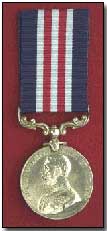Encyclopedia - Military Medal
 The Military Medal was
established in wartime Britain by
King George V
on 25 March 1916, a year and a half after Britain declared war against
Germany. Its inception was intended to meet the enormous demand for
medals during the First World War.
The Military Medal was
established in wartime Britain by
King George V
on 25 March 1916, a year and a half after Britain declared war against
Germany. Its inception was intended to meet the enormous demand for
medals during the First World War.
The medal was initially awarded to NCOs and men of the Army (including the Royal Flying Corps and Royal Naval Division) for individual or associated acts of bravery which were insufficient to merit an award of the Distinguished Conduct Medal (or DCM). Wartime recipients included the airman James McCudden (who achieved 57 aerial victories as an air ace).
The medal was not however restricted to British or Commonwealth subjects. Foreign recipients included the Frenchman Rene Fonck and the American Raoul Lufbery. The medal was awarded on the recommendation of a Commander-in-Chief in the field. A silver laurelled bar was awarded for subsequent acts of bravery and devotion under fire.
The medal was subsequently awarded to women: two were awarded to two civilian women in recognition of their role during the 1916 Easter Rising in Dublin.
Awards of the medal were announced in the London Gazette (without an accompanying citation).
Recipients of the medal, which was silver and circular of 36mm in diameter and which featured the head of the monarch on the front, were allowed to list the letters 'MM' after their name. As many as 115,600 were awarded during the First World War, along with 5,796 first bars, 180 second bars and 1 third bar. A further 15,000 Military Medals were awarded during the Second World War.
'Push' was slang signifying a large-scale attack upon enemy positions.
- Did you know?
